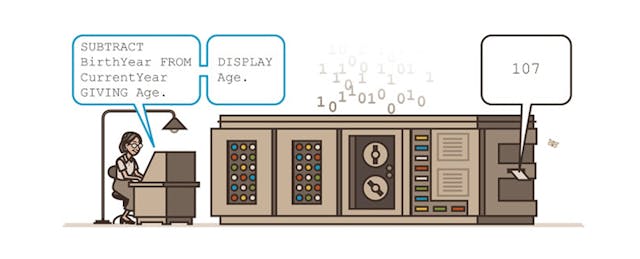Did you know that Computer Science Education week (CS Ed Week) and the 'Hour of Code' movement are celebrated every year during the week of Grace Hopper's birthday?
Due to the extent of Grace Hopper’s accomplishments in computer science and her naval rank, she is sometimes referred to as "Amazing Grace." For computer science (CS) teachers all over, CS Ed Week is a time to pause, reflect on the contributions in computer science--including from 'Amazing Grace'--and celebrate what we are fortunate to be doing every day: computer science education.
This year, I decided to start my CS Ed Week celebrations early with a lesson using the Google Doodle for Grace Hopper’s birthday from last year, combining history, art and computer science. Take a look--maybe you’ll be able to use it in your classroom during CompSci Week!
OPENING: Introducing Grace
Playing the Google Doodle animation engaged my sixth grade students and served as the perfect opening to a discussion on Grace Hopper. They loved the story of her team finding a real moth in a computer and making the word ‘bug’ and ‘debugging’ (removing a glitch in the code) popular in computer science.
Students also noticed the 1's and 0’s coming out of the top of the machine. It was my chance to explain that, thanks to Grace Hopper, we can write code in a more English-like programming language instead of writing in machine code, since Hopper invented the first ‘compiler’ that converted the Cobol programming language to 1’s and 0’s. Students appreciated her even more after that story!
HISTORY: Teaching about Computing in World War II
Within this lesson was a chance to discuss the history of it all.
Students were fascinated when I told them about the size of the computer Hopper was programming in World War II. At 51 feet long, we decided that it was almost twice the size of the classroom--and a lot bigger than relatively tiny Mac desktops!
My students and I discussed about how computers would be used in a war, which was an opportunity to remind students that computers have played an important role in our history--it is a lot more than computer games. In one of my classes, a student asked about the upcoming movie ‘The Imitation Game’, about Alan Turing’s legacy as a code-breaker during World War II. This was a perfect extension to the Grace Hopper conversation and it helped students see the evolution of computers beyond the more familiar innovations from Apple, Google or Facebook.
ART AND COMPUTER SCIENCE: Trying Out Debugging
For all my students, especially for the girls in the class, it was my subtle reminder that women have always been a part of the computer science field--and that when it comes to debugging, persistence is key.
To celebrate Grace Hopper’s real bug, as well as the great work she did, we followed our history discussion with a debugging activity. This involved students opening small Scratch projects where the code does not work correctly. Students identified the glitch or ‘bug,’ figured out why it is working incorrectly, and then changed the code. Since this can be a challenging and sometimes frustrating activity, students were encouraged to work with a friend in the class, and this collaboration ensured that students did not give up as quickly since they could problem solve together.
To celebrate each bug that was fixed, students were asked to draw a bug on the whiteboard upon completion, and there was a friendly class competition as they compared their results with other classes. I am not sure if they enjoyed the debugging more, or the bug drawing exercise more, but it was a fun, busy and learning-filled class. Many in the class declared that they were better at fixing bugs than at drawing bugs. Maybe it is time for a short art lesson!
In addition to debugging some smaller projects from the Scratch Education team’s online workshop, students enjoyed debugging a bigger project--a melting snowmen game where the snowmen do not all melt correctly.
CONCLUSION
My objective in this lesson was for my sixth graders to learn a little history behind the machines they use every day, as well as critical thinking skills as they debugged the projects. Most of my students experienced the pure joy all programmers get when they fix a bug and everything just works.
Students sometimes take the computer for granted, and think of it only in terms of its use in the moment. But by the end of this lesson, I loved that many students asked me follow-up questions on Grace Hopper, and expressed joy at getting to debug just like her. As we explore some new tools using the ‘Hour of Code’ tutorials this week, I know my students will connect this CS Ed Week with our celebration of Grace Hopper’s contributions to computer science.
Interested in doing this Grace Hopper lesson in your classroom during or after CS Ed Week? Check out my lesson plan, as well as the Scratch debug activities we did in class, linked here and here. Happy CS Week!


